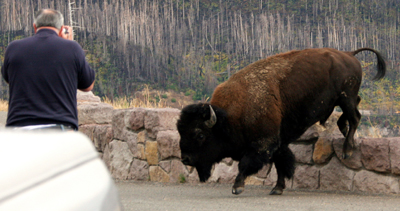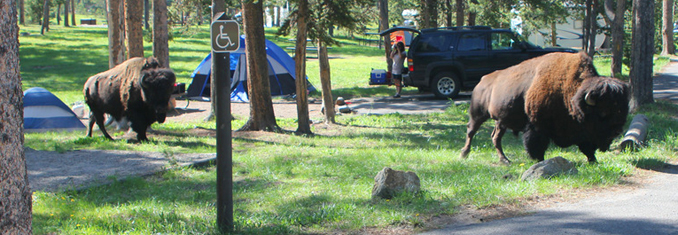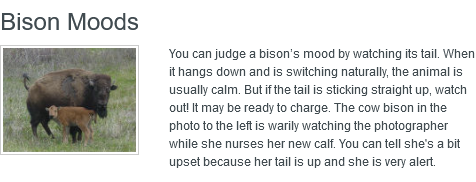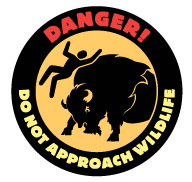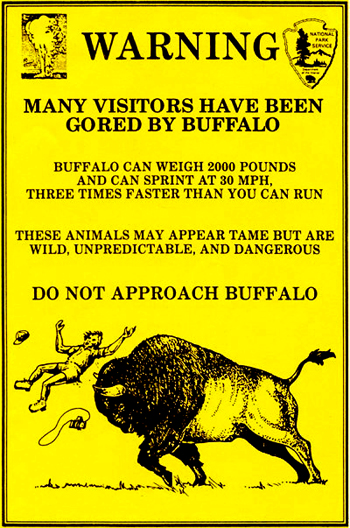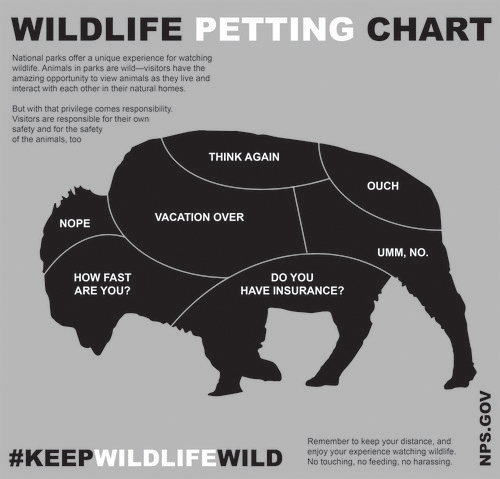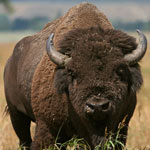
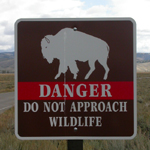

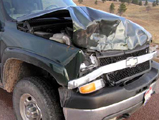
What people were doing before a bison charged them, and injuries they received, as well as how to tell the “mood” of a bison.
(Bison are also called buffalo.)
From a Yellowstone study:
“apparently unusual actions or warning activities by bison just before they charged.
Bison ‘false-charged’ in only one case, stamped feet in one case, and snorted in another case.
In two cases, the bison shook its head before charging.
Rolling on the ground (wallowing) immediately preceded two charges.
In three cases, bison butted trees just before they charged toward humans.
Tail-raising is commonly considered a sign that bison are agitated.
We found that snorting, head shaking, foot-stomping, tree-thrashing, or wallowing may also be warning signals that a bison is about to charge.”
“Despite their size and seemingly slow moving habits, bison are surprisingly agile and can be quick to react.”
This photographer might have thought he was far enough away because he had a wall between him and the bison, but bison are capable of hopping quickly over walls:
__________________
Bison sometimes wander through park campgrounds (notice the size of these two bison in comparison to the tents):
__________________
Here, bison walking over a boardwalk in a Yellowstone geyser basin:

__________________
The National Park Service also warns: bison (buffalo) “are unpredictable and dangerous. Visitors are advised to give the animals enough space and alter their plans to avoid interacting with an animal in close proximity.”
Bison can run three times faster than humans can sprint.
Bison can spin around faster than a horse.
Bison are strong swimmers.
Don’t count on a bison giving warning. Stay a minimum 100 feet (or more) away from all large animals so you won’t contribute to further studies.
Park rules say do not approach wildlife, remain a safe distance away. Stay 100 yards from bears or wolves and 25 yards from other wildlife including nesting birds.
There are no “deterrents” to a bison charge, you must keep your distance. You should stay far enough away from bison, bears, moose, elk and other wild animals that they do not notice you and you do not need to feel as though you need to run from them.
Keep the animal’s line of travel or escape route clear and move away if wildlife approaches you.
How far away is 100 yards? Picture the length of a football field without the end zones.
25 yards? picture four car lengths or six kayak lengths, or the width of an Olympic-sized pool like ours at the college.
If you have an accidental, surprise or inadvertent closer encounter with wildlife you must remove yourself to those distances, including while driving on a road.
Grand Canyon National Park rangers say: “Follow the rule of thumb: if you can cover the entire wild animal with your thumb you’re at a safe distance. This distance is usually 25 yards from most wildlife and 100 yards from large wildlife. If you are close enough to take a selfie with an animal, you are too close. ” See: they were just taking a selfie
Parks Canada warns, along with keeping a proper distance from animals :
“If you spot the following defensive warning signals, pull back even more or leave the area:
Bears make a ‘woofing’ noise, growl and snap their jaws;
Bull elk and moose put their heads down and paw at the ground;
Cow elk flatten their ears, stare directly at you and raise their rump hair.
If you cause an animal to move, you are too close.”
This NPS photo came with this warning:
“when a moose is stressed it will lay its ears back along its head and its hackles will rise.”
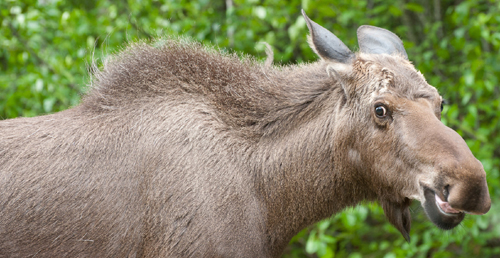
• Denali National park warns: “Moose are not predatory, and they will not try to eat you.
Instead, they try to trample a perceived threat.”
__________________________________
photo below was from https://www.bisonrange.org/
The NPS offered a coloring page people can download and color, with this description of how a bison holds its tail, depending on the mood of the bison.
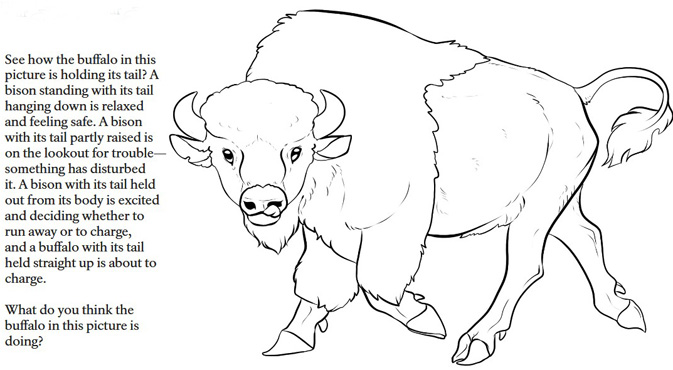
In this photo of a bison about to cross a road, note the size of the bison in comparison to the people and their cars. (Bison are 10-12 feet long, 5-6 feet tall at the shoulder, males weigh up to 2,000 pounds – about the same weight as a Scion XB or Volkswagen Beetle.) If the bison decided to change his direction of travel, or move quickly, people could have been injured. Children trying to stand/hide behind an open car door could be caught between the door and the vehicle if the bison moved quickly and charged the door.
Safe Distances from Wildlife includes reasons to stay away from even friendly seeming animals in parks, and charts and photos to better be able to determine and visualize how far away from wildlife you need to stay to be safe (and obey laws that do have penalties).
wildlife jams has some safety info and etiquette.
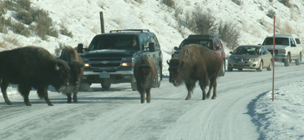
__________________________________
To read the entire NPS article below, including Surprise Encounters, go to:
https://www.nps.gov/yell/learn/upload/YS_11_1_sm.pdf
“During the 20-year period from 1980 to 1999, bison injured more of Yellowstone’s visitors than did any other animal. During this period, bison charged and made contact with humans 79 times…bison charged but did not make contact with humans 16 times.
For comparison, there were 24 bear inflicted human injuries…
Between 1963 and 1974, seven people were gored by bison, including one human fatality in the Lower Geyser Basin in 1971, when a man was killed instantly while being photographed with a bison. No bison-human incidents were reported from 1966 through 1968, or in 1970, 1973, or 1979 through 1981. We compiled a detailed summary of bison-human encounters that occurred between 1990 and 1999. In that period,
11 people were thrown into the air by bison for distances of up to 15 feet.
One person was thrown against a parked car;
one was thrown onto the bison’s back where he was gored a second time as the bison twisted its head;
one man was thrown 15 feet into the air, did a flip, and landed in a tree.
A photographer lying on the ground was trampled by a charging bison, and told the investigating ranger that the bison then ‘sat’ on him…
Thirty-four reports provided details on what people were doing just before a bison charged.
In 10 cases, they had approached to pose with or to photograph bison from distances of from two to 51 feet.
Six people were within 10 feet of the bison when it charged.
Two people were approaching within 20 feet to have a closer view, and two others were either petting or feeding the bison when it charged.
In two other cases, bison charged after sticks or stones were thrown at them.
In the 35 cases where the reporting ranger attempted to estimate the distance between the bison and human when the bison charged, the average distance was 28.5 feet…
Bison-caused injuries to humans, 1990-1999
a) puncture wounds to the: thigh (7), lower back (2), buttock (2), abdomen (1),
groin area (1), leg (1), side (1), and chest (1);
b) lacerations to the: head (2), and thigh (1);
c) fractured: clavicle (1), humerus (1),and rib (1);
d) abrasion of the: arm (2), thigh (1),knees (1), and groin area (1);
e) injury to: wrist (1), pneumothorax (1), and elbow (1); and
f ) broken: elbow (1), ribs (1), arm (1).”
At https://www.nps.gov/yell/planyourvisit/safety.htm we read:
“Bison have injured more people in Yellowstone than any other animal. Bison are unpredictable and can run three times faster than humans. Always stay at least 25 yards (23 m) away from bison.
Give bison space when they are near a campsite, trail, boardwalk, parking lot, or in a developed area. If need be, turn around and go the other way to avoid interacting with a wild animal in close proximity.
Approaching bison threatens them, and they may respond by bluff charging, head bobbing, pawing, bellowing, or snorting. These are warning signs that you are too close and that a charge is imminent.
Do not stand your ground. Immediately walk or run away from the animal. Spray bear spray as you are moving away if the animal follows you.”
__________________________________
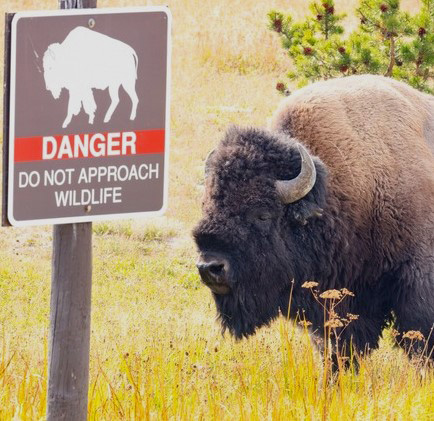
These are incident reports mostly from the National Park Service Daily report or park press releases.
From Yellowstone National Park
“Second visitor in three days gored by bison in Yellowstone National Park
June 30, 2022
Visitors: Bison are wild and unpredictable. Stay more than 25 yards (23 m) away from them.
Incident details
• A 71-year-old woman from West Chester, Pennsylvania, was gored by a bull bison near Storm Point at Yellowstone Lake on Wednesday, June 29.
• The woman and her daughter inadvertently approached the bison as they were returning to their vehicle at the trailhead, causing the bull bison to charge.
• The woman sustained non-life-threatening injuries after the encounter and was transported by ambulance to West Park Hospital in Cody, Wyoming.
• This incident remains under investigation, and there is no additional information to share.
• This is the third reported bison and visitor incident in 2022. On May 30, a woman approached a bison near a boardwalk at Black Sand Basin, and a man approached a bison near a boardwalk at Giant Geyser on June 28.
How to view wildlife safely
• Wildlife in Yellowstone National Park are wild and can be dangerous when approached.
• Give bison space when they are near a campsite, trail, boardwalk, parking lot, or in a developed area. If need be, turn around and go the other way to avoid interacting with a wild animal in close proximity.
• Stay more than 25 yards (23 m) away from all large animals – bison, elk, bighorn sheep, deer, moose, and coyotes – and at least 100 yards (91 m) away from bears and wolves.
• Approaching bison threatens them and they may respond by bluff charging, head bobbing, pawing, bellowing, or snorting. These are warning signs that you are too close and that a charge is imminent.
• Do not stand your ground. Immediately walk or run away from the animal. Spray bear spray as you are moving away if the animal follows you.
• Bison are unpredictable and can run three times faster than humans.”
https://www.nps.gov/yell/learn/news/220630.htm
__________________________________
from Yellowstone National Park
“Woman gored after approaching bison in Yellowstone National Park
June 29, 2020
After a 72-year-old woman from California approached within 10 feet of a bison multiple times to take its photo, the animal gored her.
The incident occurred on the evening of June 25, 2020, at the female’s campsite at Bridge Bay Campground.
Rangers provided immediate medical care to the woman who sustained multiple goring wounds. She was then flown via helicopter to Eastern Idaho Regional Medical Center.
“The series of events that led to the goring suggest the bison was threatened by being repeatedly approached to within 10 feet,” said Yellowstone’s Senior Bison Biologist Chris Geremia. “Bison are wild animals that respond to threats by displaying aggressive behaviors like pawing the ground, snorting, bobbing their head, bellowing, and raising their tail. If that doesn’t make the threat (in this instance it was a person) move away, a threatened bison may charge. To be safe around bison, stay at least 25 yards away, move away if they approach, and run away or find cover if they charge.” ”
__________________________________
from Yellowstone National Park
“Female visitor injured after approaching bison in Yellowstone National Park
May 20, 2020
On the afternoon of May 20, 2020, a female visitor was knocked to the ground and injured by a bison in the Old Faithful Upper Geyser Basin after approaching the animal too closely (inside 25 yards).
Park emergency medical providers responded to the incident immediately. She was assessed and refused transport to a medical facility.”
__________________________________
from Yellowstone National Park
” Nine-year-old girl injured by bison
Date: July 23, 2019
On the afternoon of July 22, there was an incident with a bull bison near Observation Point Trail in the Old Faithful Geyser area.
According to witnesses, a group of approximately 50 people were within 5-10 feet of the bison for at least 20 minutes before eventually causing the bison to charge the group.
A nine-year-old girl from Odessa, FL was charged and tossed into the air by the bull bison.
The girl was taken to the Old Faithful Lodge by her family where she was assessed and treated by a park emergency medical providers, and later taken to and released from the Old Faithful Clinic.
No citations have been issued. The incident is still under investigation.
Wildlife in Yellowstone National Park are wild. When an animal is near a trail, boardwalk, parking lot, or in a developed area, give it space. Stay 25 yards (23 m) away from all large animals – bison, elk, bighorn sheep, deer, moose, and coyotes and at least 100 yards (91 m) away from bears and wolves. If need be, turn around and go the other way to avoid interacting with a wild animal in close proximity. ”
__________________________________
“Woman gored by bison after crowd gets too close
June 7, 2018
On the morning of June 6, 59-year-old Kim Hancock of Santa Rosa, California, was gored by a bull bison at Fountain Paint Pot in the Lower Geyser Basin.
Hancock and a crowd of people approached within ten yards of the bison while walking along a boardwalk. At one point, people were closer than 15 feet from the bison. When it crossed the boardwalk, the bison became agitated and charged the crowd, goring Hancock. The bison immediately left the area.
Rangers responded to the incident and treated Hancock for a hip injury: she was transported by paramedic ambulance to the Big Sky Medical Center in Big Sky, Montana, in good condition.
This incident remains under investigation.
This is the second incident of a bison injuring a visitor in 2018 (previous release: Bison injures visitor at Old Faithful). There was one incident in 2017 and five in 2015.
In a little over a month, four people have been injured by wildlife in Yellowstone.
Animals in Yellowstone are wild and unpredictable, no matter how calm they appear to be. Give animals space when they’re near trails, boardwalks, parking lots, or in developed areas. Always stay at least 100 yards (91 m) away from bears and wolves, and at least 25 yards (23 m) away from all other animals, including bison and elk. If you can’t maintain these distances, turn around and find an alternate route.”
__________________________________
Yellowstone National park news release
“Bison injures visitor at Old Faithful
May 2, 2018
On the afternoon of May 1, 72-year-old Virginia Junk of Boise, Idaho, was butted in the thigh by a bison in the Old Faithful area. (It was originally reported that Mrs. Junk was “butted in the thigh, pushed, and tossed off a trail.”)
Junk did not see the animal as she walked around a bend in the trail and wasn’t able to move away before the animal dropped its head and pushed her off the trail.
Rangers responded to the incident and treated Junk’s minor injuries.
Junk was transported by ambulance to Madison Memorial Hospital in Rexburg, Idaho.
No citations were issued.
This is the first incident of a bison injuring a visitor in 2018. There was one incident in 2017 and five in 2015.
Animals in Yellowstone are wild and unpredictable, no matter how calm they appear to be. When an animal is near a trail, boardwalk, parking lot, or in a developed area, give it space. Always stay at least 100 yards (91 m) away from bears and wolves, and at least 25 yards (23 m) away from all other animals, including bison and elk. If need be, turn around and go the other way to avoid interacting with a wild animal in close proximity. ”
__________________________________
This tale is of a selfie gone wrong.
“Thursday, July 23, 2015
Yellowstone National Park (ID,MT,WY)
Woman Injured In Encounter With Bison
A 43-year-old woman from Mississippi received minor injuries Tuesday when she turned her back on a bison to get a photo with it near the Fairy Falls trailhead. She was the fifth person injured after approaching bison this season.
The woman and her daughter were by the trailhead sign when they decided to take a picture with a bison that was approximately six yards away from them near the trail. When they turned their backs to the bison to take the picture, someone warned that they were too close. They heard the bison’s footsteps moving toward them and started to run, but the bison caught the mother on the right side, lifted her up and tossed her with its head. The woman’s father covered her with his body to protect her and the bison moved about three yards away. The family drove to the Old Faithful Clinic, where the woman was treated and released with minor injuries.
“The family said they read the warnings in both the park literature and the signage, but saw other people close to the bison, so they thought it would be OK,” said Old Faithful District Ranger Colleen Rawlings. “People need to recognize that Yellowstone wildlife is wild, even though they seem docile. This woman was lucky that her injuries were not more severe.”
The park has again reminded visitors that wildlife should not be approached, regardless of how tame or calm they appear. When an animal is near a trail, boardwalk, parking lot, or in a developed area, visitors must give it a wide berth and not approach it closer than the required minimum distances – 25 yards away from all large animals (bison, elk, bighorn sheep, deer, moose, and coyotes) and at least 100 yards away from bears and wolves.
Bison can run three times faster than humans can sprint and are unpredictable and dangerous. Visitors are advised to give the animals enough space and alter their plans to avoid interacting with an animal in close proximity.
[Submitted by Public Affairs Office] ”
__________________
Yellowstone
“June 2, 2015
A 62-ear-old man Australian man sustained serious but non-life-threatening injuries after an encounter with a bison . . . several people were crowding a bison that was lying on the grass near an asphalt path, when the man approached the bison while taking pictures with an electronic notepad. He got to within 3 to 5 feet of the bison when it charged him, tossing him into the air several times.”
__________________
from the National Park Service Morning Report, Thursday, June 25, 2009
“Yellowstone National Park
Woman Injured By Bison
A 50-year-old woman from Spain was butted and tossed in the air by a bull bison at Canyon yesterday morning. The woman and her husband were using a pay phone in the Canyon lodging area with their backs to the road. According to witnesses, two bull bison walked down the road, passing within 20 feet of the couple. One of the bison left the road, walked up behind the woman and butted her into the air. The couple, who were facing away from the road, did not see the bison coming. The injured woman was transported to the Canyon Lodge front desk by visitors, then taken by ambulance to the Lake Clinic, where she was released with only minor injuries. Visitors are urged to be aware of their surroundings and to be very cautious around wildlife, as they are unpredictable. Extremely serious injuries or death can result from approaching wild animals too closely or allowing wild animals to approach you even if they appear docile. Park regulations require that a minimum distance of 100 yards be maintained from bears and wolves, and 25 yards from all other animals. [Submitted by Public Affairs]”
__________________
YELLOWSTONE NATIONAL PARK NEWS RELEASE
“Boy Injured By Yellowstone Bison June 27, 2008
A 12-year-old Pennsylvania boy was flipped in the air by a bison near the Grand Canyon of the Yellowstone this morning.
A mature bull bison, apparently annoyed at the close proximity of the boy, tossed him approximately 10 feet in the air. Witnesses said the boy was posing with members of his family within 1-2 feet of the animal despite repeated warnings from other visitors. The incident occurred just off the trail adjacent to the Uncle Tom’s Trail parking lot along the South Rim Drive of the Grand Canyon of the Yellowstone.
The bull’s horns did not puncture the boy. The only outward injuries he suffered were abrasions possibly received from hitting the ground after the fall.
Because the boy complained of abdominal pain, he was transported by ambulance to the Lake Clinic and then flown to the Eastern Idaho Regional Medical Center in Idaho Falls. The name and hometown of the injured juvenile aren’t being released. His current condition is not available.
Visitors are urged to be very cautious around the park’s wildlife. Extremely serious injuries or death can result from approaching wild animals too closely even if they appear docile. Park regulations require that a minimum distance of 100 yards be maintained from bears and wolves, and 25 yards from all other animals.”
__________________
from the National Park Service Morning Report Tuesday, July 16, 2002
“Yellowstone NP (WY) – Visitor Gored by Bison
A bull bison gored 37-year-old Paul Jocelyn of Albertville, Minnesota, near Old Faithful Lodge on the afternoon of July 13th. Witnesses said that the bison was grazing near the boardwalk that connects the lodge with Old Faithful geyser. A group of visitors approached to within ten to fifteen feet to take pictures of the animal. Jocelyn stepped out from the group and walked around to the front of the bison to see if it would raise its head for a better picture. The bison chased Jocelyn into the trees, picked him up with his horns, and threw him three to four feet into the air. The bison then stared at Jocelyn and the other visitors for several minutes before walking off and resuming grazing. Jocelyn sustained a puncture wound to his inner right thigh and various scrapes and bruises. Rangers provided initial care; he was then taken to Old Faithful Clinic for treatment of his injuries.
Criminal charges are pending against Jocelyn for harassing wildlife.
No action will be taken against the bison. [Public Affairs, YELL, 7/15] ”
__________________
“from the National Park Service Morning Report
Tuesday, October 12, 2004
Yellowstone National Park (ID,MT,WY)
… on the night of October 6th. A 24-year-old Michigan man who works for the park concessioner was walking back to his dorm at Old Faithful around 11:20 p.m. when he was surprised from behind by a bison. The bison gored him in the rear and lifted him into the air, landing him face down.
He was treated for a two-and-a-half inch puncture wound and received stitches in his face at the Old Faithful Clinic. [Submitted by Office of Public Affairs]”
__________________
from Your Safety while traveling in Grizzly Bear territory
Bear attacks and other animal attacks are not common, but there are no guarantees of your safety.
Wild animals try to stay away from people. They become aggressive if:
- they are protecting their cubs/fawns, etc.
- you surprise them
- the bear has become used to people and food rewards from people
- your dog provokes them
- you try to get close to them for a photo, pose near them for a photo, pose your child next to them for a photo, try to run by them, pet them, feed them, tease them, throw rocks/stones at them, etc.
- you see a bear, get nervous and run. Running can elicit an attack from a non-aggressive bear.
- you somehow are not careful enough and a bear gets your food — and — you try to get it back.
- people fly drones around/over them, endangering themselves and others. Use of drones is illegal in National Parks. Please try to get the vehicle license number (and if possible make, model and color) / campsite number of anyone using a drone and report them to Rangers. If you have cell phone coverage, call park dispatch. The phone number for dispatch is usually in the park newspaper you receive when you enter the park. (When people fly drones around forest fires, the helicopters with firefighters and tankers with sprays to put out the fire can’t fly!)
__________________
Everyone who was taped in this one-minute duration National Park Service video
should have been getting far away from these elk,
not staying to watch or photograph (even hiding between their cars):
and they should have gone to safety much sooner than the woman in this photo:
__________________
Where can you find bison herds in Yellowstone? The NPS map below shows bison July-August breeding range (in dark red), Sept-May fall-winter range (orange). Bison movement routes are shown with red arrows:
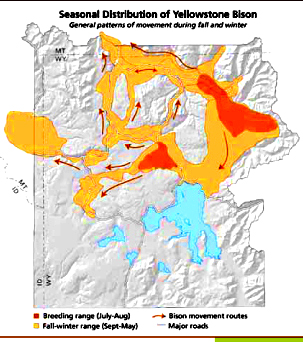
__________________
see also:
get a free download of
Yellowstone Bison: Conserving an American Icon in Modern Society
“This book examines the history of bison conservation and management in the United States, compiles the latest scientific information about Yellowstone bison, and discusses both the opportunities for and challenges to plains bison conservation within the Greater Yellowstone Area and across their historic range. . . ”
your safety in grizzly bear territory tells you what to do if you see a grizzly in the distance or if a bear charges you and has info about Bear Pepper Sprays. No, bear spray is not useful on bison or elk or . . .
Info about food storage from black bears, how black bears get into cars, what to do if you see a black bear and more is at: Bears
Grand Tetons biking includes statistics about cyclist encounters with grizzly bears.
Cell phones in the wilderness which has advice on how/when to use a cell phone to contact 911 in the wilderness and a warning about interference between cell phones, iPods and avalanche beacons.
Thunderstorm and lightning safety includes a warning about not using your cell phone or IPod during a storm.
The use of cell phones for photography (with or without a selfie stick) has made preventable injury or even death by selfie common They were just taking a selfie . . .
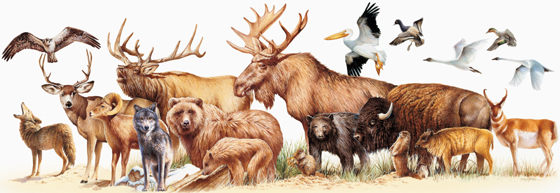 Rocky Mountain mammal size comparisons has photos and comparisons of beavers, squirrels, pika, marmot, elk, moose, bison, fox, coyote, wolf, golden-mantled ground squirrel, chipmunk, Red Squirrel (also known as) Chickaree, Unita Ground squirrels, bobcat, lynx, mountain lion (cougar), pine marten, mountain goats, bighorn sheep, pronghorn, grizzly and black bears, tundra swan, trumpeter swan, adult and juvenile Bald Eagles.
Rocky Mountain mammal size comparisons has photos and comparisons of beavers, squirrels, pika, marmot, elk, moose, bison, fox, coyote, wolf, golden-mantled ground squirrel, chipmunk, Red Squirrel (also known as) Chickaree, Unita Ground squirrels, bobcat, lynx, mountain lion (cougar), pine marten, mountain goats, bighorn sheep, pronghorn, grizzly and black bears, tundra swan, trumpeter swan, adult and juvenile Bald Eagles.
__________________
__________________
The main page about our trip between summer and fall quarters to Grand Teton National Park is Grand Tetons
__________________
__________________
(Note to on-line users not in my classes: this is a study sheet. It is not complete instruction in the topic named in the webpage title.)
The author of this webpage, (written as a homework reading assignment for my students), does not give any warranty, expressed or implied, nor assume any legal liability or responsibility for the accuracy, completeness, or usefulness of any information, product, or process included in this website or at websites linked to or from it. Users of information from this website assume all liability arising from such use.
